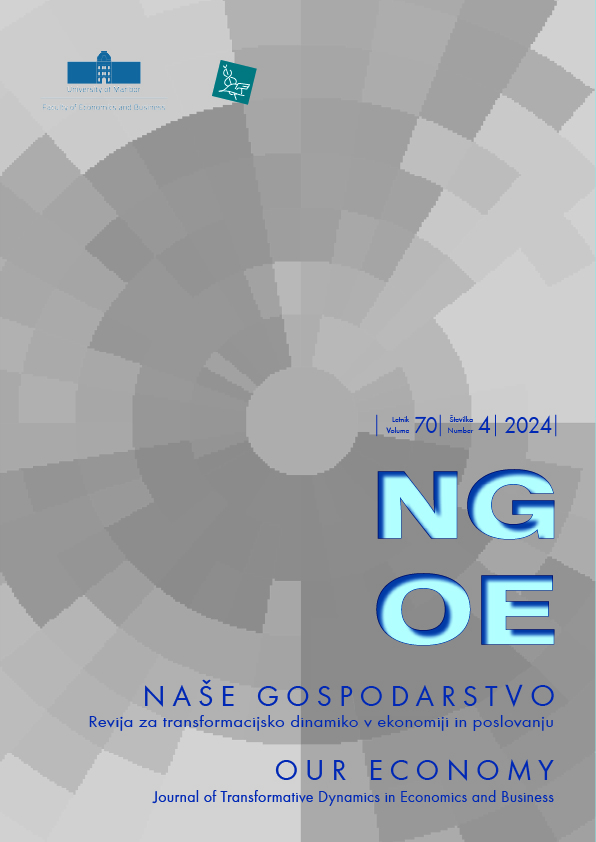Economic Inequality and the Size of Government Expenditure Shocks: An Empirical Exercise
DOI:
https://doi.org/10.18690/10.2478/ngoe-2024-0019Abstract
Empirical literature explains the heterogeneity of fiscal multiplier estimates through the analysis of various cyclical and structural determinants of economies, with economic inequality, as one of the key structural characteristics, receiving relatively little attention so far. In this study, using a wide sample of countries and applying the vector autoregression methodology, we first estimated fiscal multipliers and the impact of fiscal stimuli on the dynamics of the price level. The findings indicate that the estimated fiscal multipliers are mostly positive, and fiscal stimuli tend to produce an inflationary effect. Subsequently, we examined the variability in the size of fiscal multipliers in relation to various indicators of income and wealth inequality. The key findings of this study reveal that as economic inequality increases, particularly in the context of income disparities, the size of fiscal multipliers also rises. This insight is particularly important for policymakers in designing appropriate fiscal measures in an evolving macroeconomic environment.
Downloads
References
Agnello, L., & Sousa, R. M. (2012). Fiscal Adjustments and Income Inequality: a First Assessment. Applied Economics Letters, 19, 1627–1632. https://doi.org/10.1080/13504851.2011.648315
Auerbach, A. J., & Gorodnichenko, Y. (2010). Measuring the Output Responses to Fiscal Policy. NBER Working Paper No. 16311. National Bureau of Economic Research, Cambridge. https://doi.org/10.3386/w1631
Auerbach, A. J., & Gorodnichenko, Y. (2011). Fiscal multipliers in recession and expansion. NBER Working Paper No. 17447, National Bureau of Economic Research, Cambridge. https://doi.org/10.3386/w17447
Auerbach, A. J., & Gorodnichenko, Y. (2017). Fiscal Stimulus and Fiscal Sustainability. NBER Working Paper No. 23789. National Bureau of Economic Research, Cambridge. https://doi.org/10.3386/w23789
Auerbach, A. J., Gorodnichenko, Y., & Murphy, D. (2021). Inequality, Fiscal Policy and COVID19 Restrictions in a Demand-determined Economy. European Economic Review, 137. https://doi.org/10.1016/j.euroecorev.2021.103810
Blanchard, O., & Perotti, R. (2002). An Empirical Characterization of the Dynamic Effects of Changes in Government Spending and Taxes on Output. Quarterly Journal of Economics, 117(4), 1329–1368. https://doi.org/10.1162/003355302320935043
Brinca, P., Ferreira, M. H., Franco, F., Holter, H. A., & Malafry, L. (2021). Fiscal Consolidation Programs and Income Inequality. International Economic Review, 62(1), 405–460. https://doi.org/10.1111/iere.12482
Brinca, P., Holter, A. H., Krusell, P., & Malafry, L. (2016). Fiscal Multipliers in the 21st Century. Journal of Monetary Economics, 77, 53–69. https://doi.org/10.1016/j.jmoneco.2015.09.005
Burriel, P., de Castro, F., Garrote, D., Gordo, E., Paredes, J., & Pérez, J. J. (2009). Fiscal Policy Shocks in the Euro Area and the US. An Empirical Assessment. ECB Working paper No. 1133. ECB, Frankfurt. https://www.ecb.europa.eu//pub/pdf/scpwps/ecbwp1133.pdf
Chen, M., & Li, P. (2023). Impact of Low Interest Rates on Income Inequality: Evidence from China. Applied Economics Letters, 1–4. https://doi.org/10.1080/13504851.2023.2259586
Credit Suisse. (2023). Global Wealth Report. Credit Suisse Bank. Retrieved from https://www.credit-suisse.com/about-us/en/reports-research/global-wealth-report.html.
Furceri, D., Ge, J., Loungani, P., & Melina, G. (2022). The Distributional Effects of Government Spending Shocks in Developing Economies. Review of Development Economics, 26, 1574–1599. https://doi.org/10.1111/rode.12888
Giordano, R., Momigliano, S., Neri, S., & Perotti, R. (2007). The Effects of Fiscal Policy in Italy: Evidence from a VAR Model. European Journal of Political Economy, 23(3), 707–733. https://doi.org/10.1016/j.ejpoleco.2006.10.005
Heimberger, P. (2020). The Dynamic Effects of Fiscal Consolidation Episodes on Income Inequality: Evidence for 17 OECD Countries over 1978–2013. Empirica, 47, 35–81. https://doi.org/10.1007/s10663-018-9404-z
Hory, M.-P. (2016). Fiscal Multipliers in Emerging Market Economies: Can We Learn Something from Advanced Economies? International Economics, 146, 59–84. https://doi.org/10.1016/j.inteco.2015.11.002
Ilzetzki, E., Mendoza, E. G., & Végh, C. A. (2013). How Big (Small?) are Fiscal Multipliers? Journal of Monetary Economics, 60(2), 239–254. http://doi.org/10.1016/j.jmoneco.2012.10.011
IMF. (2023). International Financial Statistics. IMF Data. Retrieved from https://data.imf.org/?sk=4c514d48-b6ba-49ed-8ab9-52b0c1a0179b&sid=1390030341854.
Koh, W. C. (2017). Fiscal Multipliers: New Evidence from a Large Panel of Countries. Oxford Economic Papers, 69(3), 569–590. http://doi.org/10.1093/oep/gpw066
Lütkepohl, H. (2005). New Introduction to Multiple Time Series Analysis. Berlin: Springer.
Miranda-Pinto, J., Murphy, D., Walsh, K. J., & Young, E. R. (2023). Saving Constraints, Inequality, and the Credit Market Response to Fiscal Stimulus. European Economic Review, 151. https://doi.org/10.1016/j.euroecorev.2022.104355
Moll, B., Rachel, L., & Restrepo, P. (2022). Uneven Growth: Automation's Impact on Income and Wealth Inequality. Econometrica, 90(6), 2645–2683. https://doi.org/10.3982/ECTA19417
Perotti, R. (2004). Estimating the Effects of Fiscal Policy in OECD Countries. IGIER Working Paper No. 276, Bocconi University, Milano, Italy. https://ssrn.com/abstract=637189.
Ramey, V. A., & Zubairy, S. (2014, November). Government Spending Multipliers in Good Times and in Bad: Evidence from U.S. Historical Data. NBER Working Paper No. 20719. National Bureau of Economic Research, Cambridge. https://doi.org/10.3386/w20719
World Bank. (2023). World Development Indicators. World Bank Data. Retrieved from https://databank.worldbank.org/source/world-development-indicators.
Downloads
Published
Issue
Section
License
Copyright (c) 2024 Marko Senekovič

This work is licensed under a Creative Commons Attribution-NonCommercial-NoDerivatives 4.0 International License.
